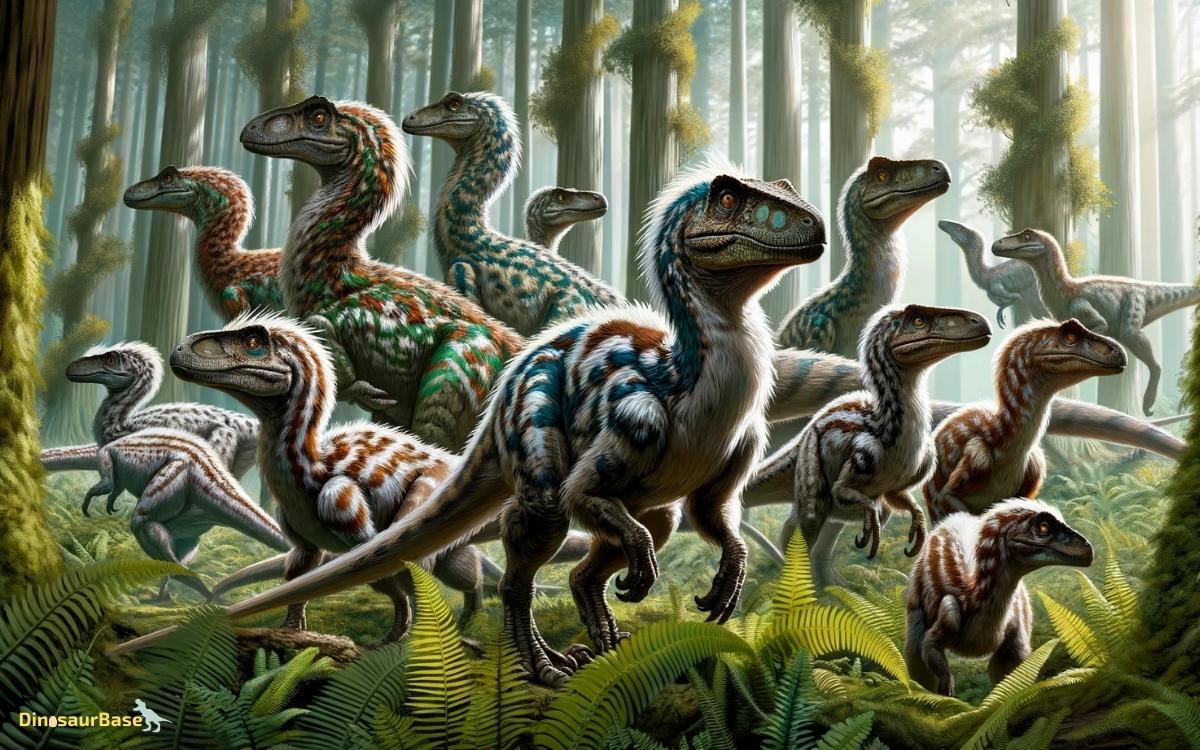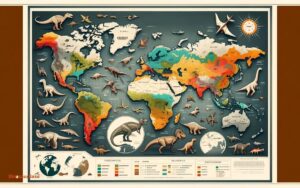Which Dinosaurs Had Feathers
The discovery of feathered dinosaurs has revolutionized our understanding of prehistoric life. It challenges long-held perceptions of these ancient creatures’ appearance and behavior.
Among the notable species, Archaeopteryx bridges the gap between dinosaurs and birds, suggesting an evolutionary trajectory that has intrigued scientists.
Meanwhile, the Velociraptor, once thought to be merely scaled, is now believed to have sported a coat of feathers. This finding alters our view of its hunting strategy and thermoregulation. This evolving narrative invites a closer examination of the fossil record.
It promises to unveil further insights into the complexity of dinosaurian life and their unexpected connections to modern avian species.


Key Takeaway
The Feathered Dinosaur Discovery
Unveiling the existence of feathered dinosaurs has revolutionized our understanding of prehistoric life, challenging long-held perceptions of these ancient creatures’ appearance and behavior.
This discovery, initially met with skepticism, has now been substantiated through meticulous paleontological research and fossil analysis.
The identification of feathered dinosaurs, primarily through the detailed examination of well-preserved specimens, underscores a significant evolutionary link between theropod dinosaurs and modern birds.
These findings not only illuminate the diversity of dinosaur integumentary structures but also suggest a complex evolutionary pathway marked by both functional and ecological adaptations.
Understanding Feather Evolution
The evolution of feathers in dinosaurs represents a pivotal point in the study of prehistoric life. It highlights a complex transition from scales to the diverse feather types observed in both extinct and extant species.
Investigating the origins of feathers in dinosaurs, along with the various forms they assumed, provides crucial insights into the selective pressures and environmental conditions favoring their development.
Furthermore, understanding the evolutionary advantages conferred by feathers, such as thermoregulation, camouflage, and flight, sheds light on the adaptive significance of this morphological innovation.
Feather Origins in Dinosaurs
Deciphering the origins of feathers in dinosaurs necessitates a deep dive into the evolutionary and paleontological evidence that illuminates this transformative adaptation in Earth’s ancient inhabitants.
The journey starts in the Middle-Late Jurassic period, where the earliest known feathered dinosaurs, closely related to avians, provide a crucial window into this evolutionary marvel.
Scientific consensus suggests that feathers evolved primarily for insulation, aiding in temperature regulation among these ancient reptiles.
Subsequent adaptations possibly included display for mating or intimidation and, eventually, aerodynamics for flight in certain lineages.
Molecular studies comparing the keratin structure in modern birds and reptiles further reinforce the shared ancestry, offering a genetic blueprint that guides our understanding of feather evolution.
This intricate synthesis of fossil records and genetic data underscores the complexity and gradual nature of feather development in dinosaurs.
Types of Dinosaur Feathers
Often, the classification of dinosaur feathers reveals a complex evolutionary narrative, characterized by a diversity of forms ranging from simple filaments to highly organized, flight-capable structures.
Initially, paleontologists identified primitive feathers as simple, hair-like filaments on the bodies of certain theropods, suggesting an early stage in feather evolution.
These structures, known scientifically as protofeathers, lacked the branching complexity of modern feathers but provided crucial insights into the incremental adaptations over millions of years.
As evolutionary processes unfolded, more intricate feather forms emerged, including downy feathers for insulation and pennaceous feathers with central vanes and barbs, enabling flight in some species.
This gradation illustrates a sophisticated evolutionary pathway, highlighting how feathers evolved from basic insulation and display functions to complex aerodynamic and thermoregulatory roles, indicative of their adaptive significance in the dinosaur lineage.
Evolutionary Benefits of Feathers
Exploring the evolutionary advantages of feathers reveals how these structures provided dinosaurs with a competitive edge in various ecological niches.
Initially, feathers may have evolved for insulation, helping to regulate body temperature in fluctuating climates, thereby enabling dinosaurs to thrive in diverse environments.
This thermal regulation could have supported higher metabolic rates, contributing to increased activity levels and possibly endothermy in some species.
Furthermore, feathers evolved to play critical roles in display and camouflage, aiding in mate attraction and predator evasion, respectively.
The modification of feathers for flight in certain theropods represents a pinnacle of evolutionary innovation, opening new ecological opportunities.
Each of these functions underscores the multifaceted benefits feathers offered, driving their evolutionary success and diversification among dinosaur lineages.
The Significance of Archaeopteryx
Archaeopteryx, a genus of early bird that lived during the late Jurassic period, represents a pivotal moment in the evolution of dinosaurs into birds, highlighted by its blend of avian and dinosaurian features.
This creature exhibits a fascinating combination of characteristics, such as feathers, a wishbone, and aspects of skeletal anatomy that are distinctly avian, alongside dinosaurian traits like a long bony tail and teeth.
The discovery of Archaeopteryx provided the first clear evidence supporting the theory that birds evolved from theropod dinosaurs, a hypothesis that has significantly influenced paleontological thought.
Its transitional features serve as a critical link in understanding the evolutionary pathway from terrestrial dinosaurs to the avian descendants we see today.
This underscores the importance of Archaeopteryx in the broader narrative of life’s evolutionary history, offering invaluable insights into the mechanisms of evolutionary change.
Velociraptor: A Feathered Predator
Renowned for its role in the iconic ‘Jurassic Park‘ series, the Velociraptor has since been revealed by paleontological evidence to have sported feathers, challenging previous perceptions of this predator’s appearance and lifestyle.
This discovery has significantly altered our understanding of theropod dinosaurs, suggesting a closer evolutionary relationship to modern birds than previously acknowledged.
The Velociraptor, a member of the dromaeosaurid family, is now believed to have had a plumage that served multiple functions, including temperature regulation and possibly display behaviors during mating rituals.
This insight is derived from well-preserved fossil specimens showing quill knobs bony projections where feathers would be anchored on the forearms, indicating the presence of feathers.
This evidence underscores the dynamic and evolving nature of our understanding of dinosaur biology, bridging gaps between the prehistoric past and the avian present.
The Majestic Microraptor
The discovery of the Microraptor has provided compelling evidence for the existence of feathered dinosaurs, showcasing a complex evolutionary lineage that links these ancient creatures to modern birds.
This small, four-winged dinosaur, which lived approximately 120 million years ago during the Early Cretaceous period, highlights the diversity and adaptability of feathered dinosaurs.
| Feature | Description | Significance |
|---|---|---|
| Size | Approximately the size of a crow | Suggests feasibility of powered flight in small dinosaurs |
| Feather Type | Asymmetrical, similar to modern birds | Indicates advanced aerodynamic capabilities |
| Habitat | Forested areas of what is now China | Provides context for ecological adaptation and niche |
| Fossil Evidence | Well-preserved specimens with feather imprints | Offers direct insight into the appearance and structure of feathers |
This evidence firmly places Microraptor within the complex tapestry of dinosaur evolution, bridging the gap between ancient reptiles and avians.
Yutyrannus: The Feathered Tyrant
In a significant departure from the smaller, more widely recognized feathered dinosaurs, the discovery of Yutyrannus huali introduces a massive theropod species adorned with feathers, challenging previous notions about the scale and ecological diversity of feathered dinosaurs.
Hailing from the Early Cretaceous period in what is now northeastern China, Yutyrannus has reshaped our understanding of theropod evolution and the extent to which feathers were prevalent among dinosaurs, especially in larger species.
- Feather Functionality: The presence of feathers suggests they might have served for insulation, indicating a potentially wider range of climates where dinosaurs could thrive.
- Size and Significance: At approximately 9 meters in length, Yutyrannus stands as one of the largest feathered dinosaurs discovered, highlighting the diversity in dinosaur integument.
- Ecosystem Implications: This discovery underscores the complexity of Cretaceous ecosystems, suggesting a broader adaptability among theropods.
Anzu: the ‘Chicken From Hell
Emerging from the late Cretaceous period’s Hell Creek Formation, Anzu wyliei, colloquially known as the ‘Chicken from Hell,’ represents a fascinating example of oviraptorosaurian dinosaurs, characterized by its bird-like features and a strikingly unusual appearance.
This creature provides a unique window into the complexity of dinosaurian evolution, particularly in the diversification of feathered dinosaurs.
| Feature | Description |
|---|---|
| Era | Late Cretaceous |
| Location | Hell Creek Formation |
| Diet | Omnivorous |
| Notable Features | Large crest, beak-like mouth, feathered body |
| Significance | Highlights bird-like evolution among dinosaurs |
Anzu’s discovery underscores the diversity within the Theropod group, challenging our perceptions of prehistoric life and further blurring the lines between traditional categories of dinosaurs and birds.
The Enigmatic Epidexipteryx
Transitioning from the discussion of Anzu, we turn our attention to Epidexipteryx, a dinosaur whose discovery has significantly contributed to our understanding of avian evolution.
The unique feather characteristics of Epidexipteryx, including its elongated tail feathers and absence of vaned flight feathers, provide insight into the diversity of feather evolution among theropod dinosaurs.
Additionally, examining Epidexipteryx’s ecological niche offers valuable perspectives on the adaptive strategies that influenced the evolutionary trajectory of feathered dinosaurs.
Unique Feather Characteristics
The enigmatic Epidexipteryx, a small dinosaur from the late Jurassic period, exhibits unique feather characteristics that challenge traditional perceptions of dinosaur plumage evolution.
This species showcases a fascinating blend of feather types not seen in contemporary birds or even closely related dinosaur species.
- Long, ribbon-like tail feathers: Unlike any modern bird, these feathers lacked barbs, suggesting they were not used for flight but possibly for display or mating rituals.
- Short, bristle-like body feathers: Offering a stark contrast to the elaborate tail feathers, these provided insulation, hinting at a complex adaptation to their environment.
- Absence of flight feathers: Indicative of a non-flying lifestyle, this trait underscores the diversity in feather function and evolution among theropod dinosaurs.
Epidexipteryx’s feather composition illuminates the diverse evolutionary pathways of dinosaurian integumentary structures, offering invaluable insights into the life and ecology of these ancient creatures.
Epidexipteryx’s Ecological Niche
Within the intricate web of Jurassic ecosystems, Epidexipteryx occupied a unique ecological niche, characterized by its distinct dietary habits and habitat preferences.
This small, feathered dinosaur is believed to have subsisted primarily on insects, a diet that suggests a highly specialized foraging behavior.
Its anatomy, particularly the structure of its beak and forelimbs, indicates adaptations for precise, targeted feeding strategies, likely involving the extraction of insects from bark or crevices.
The habitat of Epidexipteryx was densely forested areas, where such food sources would have been abundant. This environment would have also provided the necessary cover and nesting sites, further supporting the hypothesis of a highly adapted, arboreal lifestyle.
The ecological role of Epidexipteryx highlights the diversity of feeding strategies among feathered dinosaurs and their complex interactions within Jurassic ecosystems.
Sinosauropteryx: Pioneering the Feathered Look
Sinosauropteryx, recognized as one of the earliest dinosaurs to exhibit a feather-like covering, marks a significant evolutionary milestone in our understanding of dinosaur integumentary structures.
This small, carnivorous dinosaur, which lived during the Early Cretaceous period, provides crucial evidence for the existence of proto-feathers among non-avian dinosaurs. Its discovery has propelled further research into the evolutionary link between dinosaurs and birds.
- Proto-feathers: Simple filamentous structures observed in Sinosauropteryx, differing from the complex feathers of modern birds, indicating an evolutionary transition.
- Coloration: Studies suggest the presence of countershading, with a lighter underside, offering insights into its habitat and behavior.
- Evolutionary significance: Sinosauropteryx bridges an important gap in our understanding of feather development, highlighting a gradual evolution from simple filaments to the complex feather structures seen in today’s birds.
Therizinosaurus: The Mystery of Feathered Giants
Transitioning our focus to Therizinosaurus, we confront a fascinating enigma within the realm of feathered dinosaurs.
This genus, distinguished by its imposing stature and remarkably elongated claws, presents a unique case study in the examination of integumentary structures, with growing paleontological evidence suggesting the presence of feathers.
Analyzing its physical characteristics alongside feather evidence not only enriches our understanding of dinosaurian evolution but also underscores the complexity of their ecological roles and adaptations.
Therizinosaurus Physical Characteristics
One of the most striking characteristics of Therizinosaurus, a genus of theropod dinosaurs, is its unusually long, clawed forelimbs, which, alongside potential evidence of feather-like structures, contribute to its unique place within the dinosaurian lineage.
This remarkable creature, which lived during the Late Cretaceous period, exhibits a suite of features that distinguish it from other theropods.
- Massive Claws: The forelimbs ended in claws that could reach up to a meter in length, believed to be used for foraging or defense.
- Bipedal Posture: Despite its formidable claws, Therizinosaurus was primarily a biped, using its hind legs for locomotion.
- Herbivorous Diet: Contrary to many other theropods, it had a beaked mouth and a wide body adapted for a plant-based diet, challenging previous notions of theropod ecology.
Evidence of Feathers
Building on the unique physical characteristics of Therizinosaurus, recent paleontological findings suggest the presence of feather-like structures, adding a new dimension to our understanding of this intriguing dinosaur.
These evidences primarily come from fossil impressions that show filamentous integuments along the body, which closely resemble the protofeathers seen in other theropod dinosaurs.
Such integuments are not only crucial for hypothesizing the appearance of Therizinosaurus but also offer insights into its thermoregulatory strategies and potential behavioral attributes.
The analysis of these structures through microscopic and comparative studies with extant avian species has bolstered the hypothesis of feathered giants roaming the prehistoric landscapes.
This revelation challenges the traditional imagery of dinosaurs and supports the notion of a more avian-like appearance among various members of the Theropoda group.
Evolutionary Significance
The discovery of feather-like structures on Therizinosaurus has profound implications for our understanding of dinosaur evolution, particularly in terms of their phylogenetic relationships with modern birds and their adaptive strategies in diverse prehistoric ecosystems.
- Theropod Connection: Feathers on Therizinosaurus strengthen the evolutionary link between theropod dinosaurs and modern birds, suggesting a more widespread presence of feathers among non-avian dinosaurs than previously thought.
- Adaptive Significance: The presence of feathers implies a complex array of adaptive strategies, including thermoregulation, display, and possibly even primitive flight in smaller species, indicating a highly evolved response to environmental pressures.
- Phylogenetic Implications: This discovery challenges traditional dinosaur classification, necessitating a reevaluation of the phylogenetic tree and further blurring the lines between ‘bird’ and ‘dinosaur.’
The Diversity of Feathered Raptors
Feathered raptors, a fascinating subgroup within the theropod dinosaurs, exhibit a remarkable diversity in size, form, and feather arrangement, reflecting their various ecological niches and evolutionary pathways.
These adaptations not only demonstrate the evolution of flight and thermoregulation but also highlight the intricate relationship between form and function in the Mesozoic era.
Velociraptor, for instance, showcases a relatively small stature compared to its larger counterparts, yet its feathered limbs suggest a sophisticated level of thermal management and possibly, rudimentary gliding abilities.
Conversely, larger species like Utahraptor display feathers that may have been used more for display and mating rituals rather than flight.
This diversity underscores the adaptability and evolutionary experimentation within feathered raptors, revealing a complex tapestry of life that challenges our understanding of dinosaur ecology and evolution.
Scansoriopteryx: Climbing With Feathers
Exploring further the multifaceted roles of feathers in dinosaurian life, Scansoriopteryx emerges as a unique case study of arboreal adaptation facilitated by feather development.
These small, feathered dinosaurs, which lived during the Jurassic period, provide compelling evidence of how feathers might have initially evolved not for flight but for other functions such as climbing.
- Arboreal Lifestyle: Their skeletal structures suggest adaptations for climbing trees, a behavior supported by their limb morphology and tail structure.
- Feather Configuration: Scansoriopteryx had a distinct feather arrangement that likely aided in maneuvering through their arboreal habitats.
- Evolutionary Significance: This genus represents an important evolutionary link, showcasing the transition from non-avian dinosaurs to avian species, with feathers playing a critical role in their adaptability and survival strategies in diverse environments.
Reflecting on Feathers and Dinosaur Evolution
Reflecting on the evolutionary journey of dinosaurs, the emergence and diversification of feathers mark a pivotal chapter in understanding their adaptation and survival across varied ecological niches.
This development not only underscores the evolutionary plasticity inherent within these ancient reptiles but also highlights a significant evolutionary strategy that facilitated their dominance across terrestrial ecosystems.
The presence of feathers, initially posited for thermoregulation and later for flight in certain species, represents a complex interplay of genetic, environmental, and selective pressures.
Detailed phylogenetic analyses have traced the origins of feathers back to the Theropods, suggesting an evolutionary trajectory that spans millions of years, culminating in the avian dinosaurs we recognize today as birds.
This narrative underscores the importance of feathers in the evolutionary saga of dinosaurs, serving as a testament to their adaptability and resilience.
FAQ About Which Dinosaurs Had Feathers
How Did Feathers Impact the Social Behaviors of Dinosaurs, Such as Mating Rituals or Hierarchy Establishment?
Feathers likely influenced dinosaur social behaviors by enhancing visual communication for mating displays and dominance expressions.u003cbru003eTheir presence suggests complex interactions, possibly including courtship rituals and hierarchy signals within various species, reflecting a nuanced social structure.
Were There Any Specific Environmental Conditions That Accelerated the Evolution of Feathers in Dinosaurs?
Opening Pandora’s box, it’s imperative to acknowledge that specific environmental pressures, such as climate change and predation, likely played a pivotal role in propelling the evolution of feathers, enhancing survival through thermal regulation and camouflage.
How Do Paleontologists Differentiate Between Feathers Used for Flight, Display, and Insulation in Fossil Records?
Paleontologists distinguish feathers’ functions in fossils through structural analysis, observing features like branching patterns for insulation, aerodynamic shapes for flight, and vibrant preservation indicative of display, alongside contextual clues from the surrounding environment and associated species.
What Are the Current Theories on the Coloration of Dinosaur Feathers, and How Do They Contribute to Our Understanding of Dinosaur Habitats and Lifestyles?
Current theories on dinosaur feather coloration, utilizing microscopic pigment analysis, offer insights into their habitats and behaviors. Despite preservation challenges, this research enables a nuanced understanding of their ecological roles and evolutionary adaptations.
Beyond Dinosaurs, Which Other Prehistoric Creatures Are Believed to Have Had Feather-Like Structures, and What Does This Imply About the Evolution of Feathers Across Different Species?
Exploration of prehistoric creatures beyond dinosaurs reveals that several species, such as pterosaurs and certain theropods, possessed feather-like structures. This suggests a complex, evolutionary lineage of feathers, indicating diverse functionalities and ecological adaptations across ancient taxa.
Conclusion
The discovery and analysis of feathered dinosaurs have significantly reshaped the understanding of avian evolution, presenting a nuanced tapestry of life that thrived millions of years ago.
These findings underscore the evolutionary ingenuity that transformed scales into feathers, enabling a diverse array of theropods to conquer the skies.
This revelation not only illuminates the intricate pathways of natural selection but also highlights the profound connection between the behemoths of the past and the avian descendants that grace the modern skies.





